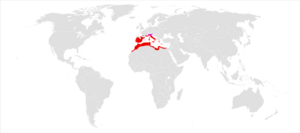Moorish gecko facts for kids
Quick facts for kids Moorish gecko |
|
|---|---|
 |
|
| Conservation status | |
| Scientific classification | |
 |
|
| Native range
Introduced range |
The common wall gecko (scientific name: Tarentola mauritanica) is a type of gecko. It naturally lives in the western Mediterranean region, including parts of North Africa and Europe. You can also find it in places like Madeira, the Balearic Islands, and even some parts of the Americas, like California.
These geckos are mostly active at night (they are nocturnal animals). They love to eat insects. You often see them on walls in cities and towns, especially in warm areas near the coast. In Spain, people sometimes let them live in their homes because they help catch insects. This gecko is strong and can grow up to 15 centimeters (about 6 inches) long. It has bumpy skin that makes it look like it's wearing armor.
The famous scientist Carl Linnaeus first described this species in 1758. People also call it the moorish gecko or crocodile gecko. In different places, it has other names like osga (in Portuguese) or salamanquesa (in Spanish).
Contents
What Does a Common Wall Gecko Look Like?
Adult common wall geckos can grow up to 15 centimeters (about 6 inches) long, including their tail. They have a strong body and a flat head. Their back, legs, and tail are covered in pointy bumps, which makes them look spiky. If their tail grows back after being lost, it will be smoother without these bumps.
They have a blunt snout and large eyes with no eyelids. Their pupils are vertical, like a cat's. Their fingers have wide growths on the sides and sticky pads underneath, which help them climb. Only the third and fourth fingers have claws.
These geckos are usually brownish-grey or brown with darker or lighter spots. Their colors can change depending on the light. During the day, when they are active, they tend to be darker than at night. You can find them in many places, like buildings, old ruins, rocky areas, and on tree trunks.
Where Do Common Wall Geckos Live?
In Europe, you can find the common wall gecko in most of the Iberian Peninsula, which includes Spain and Portugal. They also live in southern France, coastal Italy, parts of Slovenia, Croatia, and southwestern Greece.
In North Africa, their range stretches from northern Egypt, through Libya, Tunisia, and Algeria, to most of Morocco. There's also a small group that was introduced to the southern part of Western Sahara. These geckos can live in places as high as 2,300 meters (about 7,500 feet) above sea level.
Common Wall Gecko Life and Reproduction
Common wall geckos are mostly active at night or during twilight (dawn and dusk). However, you might see them out during the day, especially on sunny winter days. They like to warm up in the sun near their hiding spots.
They hunt insects for food. In warmer months, you can often spot them hunting nocturnal insects near streetlights or other light sources. Female geckos lay two almost-round eggs twice a year, usually around April and June.
After about four months, tiny geckos hatch from the eggs. They are less than 5 centimeters (about 2 inches) long when they are born. Common wall geckos grow slowly and can take 4 to 5 years to become fully grown when kept as pets.
Sometimes, when these geckos are introduced to new places, they might affect the local animals by eating small frogs or other lizards. People keeping them as pets has also led to new groups of geckos living in places like Florida.
Image gallery
-
A common wall gecko in Spain
-
A common wall gecko from the region of Montpellier
-
A common wall gecko in Portugal
See Also
- List of reptiles of Europe
- List of reptiles of Spain
- List of reptiles of Morocco
- List of reptiles of North America
- Fauna of Europe






